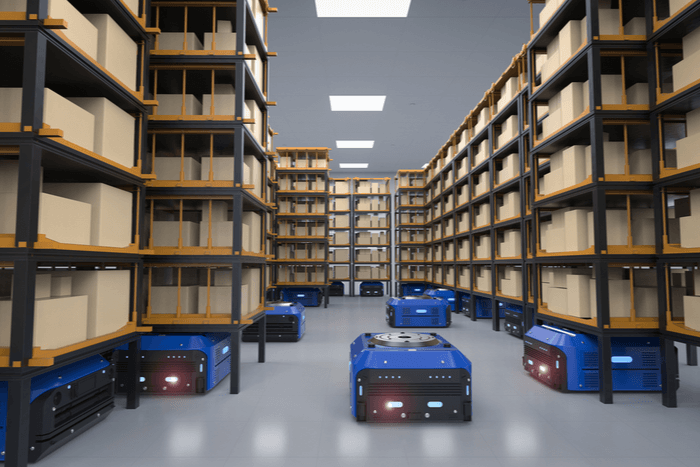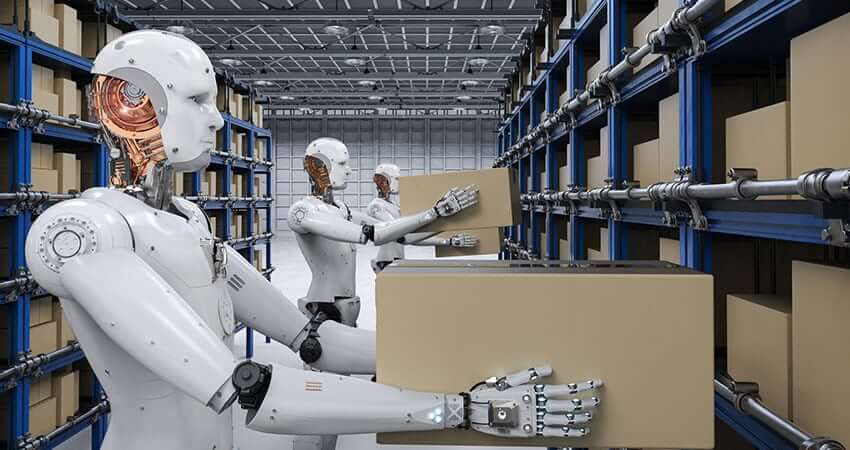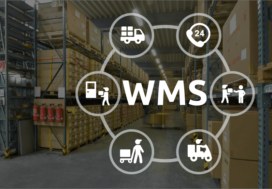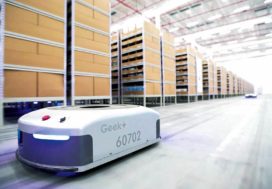
- Robots in the warehouses – the attack will continue
- Warehouse robots – basic types and scope of application
- Warehouses of the future are already available – 5 of the most innovative storehouses
- Warehouse robots of Amazon
- Robots in the warehouses by Cainiao
- Robotic automation of warehouses by Ocado
- Robotic warehouses by Sagawa X-Frontier
- Description of warehouse robots of DHL
- Is robotic automation of warehouses possible?
- Conclusion: Outlook of robotic automation
The number of automated warehouses is constantly increasing. The implementation of robots in the storehouse management system lets using staff and equipment more efficiently. In this article, we will consider the primary types of robots and scopes of their application in the warehouses and also give some examples of successful usage of an automated storage and retrieval system (abbreviated as ASRS or AS/RS).
An automated warehouse unlike the typical one can reduce operator assistance at different stages of cargo handling. Experience has shown that warehouse robots can deal with any kind of task three-four times faster than humans. Meanwhile, they never get tired or reduce productivity and can handle heavy loads. The automated assistants allow to optimize transportation of products and to manage warehouse stocks, to use the territory of storehouse more effectively, and to avoid mistakes caused by human factor.
Robots in the warehouses – the attack will continue
Today the management of warehouse complexes has to meet new requirements. This is due to global economic processes, market conditions, and changed customer behavior. Every year warehouse robots become more complex, they gain new features. Internet of things, artificial intelligence, big data, blockchain, and other innovative technologies let solve efficiently more and more challenging tasks.
Recently ASRS was used mainly for handling a large amount of cargo. Robots were applied for repeated actions with goods of the same size that are located nearby. With the development of e-commerce, it is necessary to automate different actions with diverse products and small orders. Warehouse robots are used not only for receiving goods and cargo transportation but for order picking and shipment of products to customers. The robotic automation of small and medium-sized warehouses is considered to be unbeneficial. Today it demonstrates, however, its efficiency: in addition to huge retailers, shipping, and logistics companies, an increasing number of small businesses use an automated storage and retrieval system. There is an increasing demand for ASRS. According to the consulting company Logistics IQ, a turnover of automated warehouses would be 27 billion dollars by 2025.
Warehouse robots – basic types and scope of application
Modern warehouse robots are divided into two groups: industrial and collaborative.

Industrial robots are programmable vehicles that replace manual labor in case of complicated repetitive actions. This vehicle is equipped with real-time data sensors. In warehouses, this type is represented by lifting mechanisms and automatic transporters.
Collaborative robots, or cobots, are robots intended for human-robot interaction. These devices do certain things in cooperation with the person. One of the advantages of cobots is the ability to program them so that they can work autonomously or under human control. In the sphere of warehousing, cobots are represented by manipulators for cargo transfer and packing machines.
Warehouse robots are used for the automation of the following processes.
Shelving service. The loading and unloading of products in storage facilities with the use of material handling equipment: pallet shuttles, stackers, and manipulators.
Cargo transportation. Conveyors, conveyor systems for pallets (rail, roller, suspension), or automatically controlled vehicles (AGV) transfer cargo from one place to another inside the warehouse or between the warehouse and manufacture.
Order picking. Collaborative robots in warehouses carry out automatic or semi-automatic order picking. This type includes manipulators for handling heavy goods manipulators, packing machines that can calculate and prepare material for packaging certain types of items, all kinds of picker robots, and mechanical exoskeletons that can adjust to the movement of the user and reduce physical effort while performing movements.
An alternative classification of warehouse robots by type is presented in the article.
Warehouses of the future are already available – 5 of the most innovative storehouses
Cost-cutting on staff, speed, and accuracy of operations, reduction of workload per person are the main arguments for the robotization of warehouses. The experience of the best players in the market shows, that automated systems have gradually replaced human labor. The following are the most interesting examples of robotic automated warehouses where the operator’s involvement has been minimized.
Warehouse robots of Amazon
The largest online store in the world has at its disposal more than 200,000 robots that are engaged in warehouses in 180 countries. Automated systems for the giant are developed by its own company AmazonRobotics (formerly KivaSystems), which passed into the ownership of the corporation in 2012.
The Amazon robotic automated warehouse uses systems to transport items automatically. Goods are transferred through the warehouse by human-operated conveyors and loaders. Products are stored on portable shelves. After the item is entered into the database, the system sends an unmanned robot to it. The robot picks up the shelf with the product and transports it to the operator, who selects the proper item. Warehouse robots move around the complex using QR codes on the floor. Sensors prevent robots from colliding with each other. Robots are capable of self-charging.
Robots in the warehouses by Cainiao
Cainiao, или China SmartLogistics Network, is a Chinese logistics company launched by Alibaba Group, that ensures delivery within 24 hours to any region of China and within 72 hours all over the world. The company owns 30 warehouses with a total area of 1.7 million m2. The warehouse in Huiyang, Guangdong province uses for cargo transfer unmanned robots developed by Quicktron Intelligent Technology. The maneuvering robots can rotate to 360° and move weights up to 500 kg. The built-in laser system allows avoiding a collision. Communication with the operator and receiving tasks is carried out via Wi-Fi. If the battery is low, the robot can replenish the energy supply automatically. According to the company, unmanned warehouse robots have reduced staff labor by 70%.
Robotic automation of warehouses by Ocado
Ocado is the largest online food retailer in the United Kingdom. The distribution center in Andover handles 65,000 orders per week. The feature of the automatic system is that the robots move on the rails over the cells with the goods along the special grid marking. Their movement is controlled by a 4G-based traffic control system that avoids collision. Robots reach a speed of 4 m/s. Battery charging is done automatically in special cells. Robots bring boxes of products to sorting stations, where a robot or a person completes orders. The empty cells are then filled with new items.
Robotic warehouses by Sagawa X-Frontier
Sagawa Global is one of the largest logistics companies in Japan. The new Sagawa X-Frontier warehouse in Tokyo is a modern automated complex. With the use of a large number of robots and artificial intelligence systems, the company manages warehouse stock, arranges storehouse space, transports cargo between buildings, and even delivers orders directly to staff that works in the warehouse.
Description of warehouse robots of DHL
Since 2020, logistics company DHL has used the robots of its partner, the American developer of autonomous mobile robots Locus Robotics. So-called LocusBots are already used in dozens of warehouses in North America. The robots can move independently, find the necessary goods and deliver them to employees. Therefore the company reduces the time for performance of repetitive or physically demanding tasks.
| Company | Location of the warehouse | Automation of the process | Features of the system |
| Amazon | Branches all over the world | Cargo transportation | Unmanned robots deliver goods to operators. Movement control by the use of QR codes on the floor. |
| Cainiao | Huiyang District, PRC | Cargo transportation | Mobile delivery robots. Control via Wi-Fi. |
| Ocado | Andover, United Kingdom | Cargo transportation, order picking | Movement into the grid. 4G-technology of movement control. Deliver goods to the operator. Replenish products in cells. |
| Sagawa X-Frontier | Tokyo, Japan | Cargo transportation, order picking | Unmanned robots, movement is controlled by the use of QR codes on the floor. |
| DHL | North America | Cargo transportation, order picking | Robots deliver goods to staff members, which then enter them by the use of QR codes into the system. |
Is robotic automation of warehouses possible?
Despite significant technical progress, robotization of all warehousing processes isn’t yet possible. Even the most modern equipment requires human involvement in one way or another. The operator still has to control complex or variable actions. Usually, it is possible to robotize a particular area or process. However, leading warehousing developers such as Dematic are involved in the implementation of the idea of the dark warehouse (about the concept of the dark store we have already reported on the blog) – a fully automated warehouse that does not need to be illuminated because all processes are managed without human participation. Experts predict the emergence of a new generation of robots in the nearest future.
Conclusion: Outlook of robotic automation
Robotic automation of warehouses has some significant advantages. This is a cost-cutting on staff, an increase in efficiency and speed of tasks that are carried out by robots, and optimization of warehouse space. Enterprises that already use the robotization of warehouses can already appreciate the benefits of automation of warehouse processes during the COVID-19 pandemic. At this particular time, the ability to solve multiple tasks with minimal use of human resources has become of primary importance.
The functioning of a fully automated warehouse without the involvement of the operator is still impossible. But the experience of large enterprises such as Amazon, Cainiao, Ocado, Sagawa X-Frontier, DHL shows how to use the work of people and equipment more effectively today. The robotic automation of warehouses has only begun to take shape, and managing all the warehousing processes without human intervention is a real prospect in the future.




